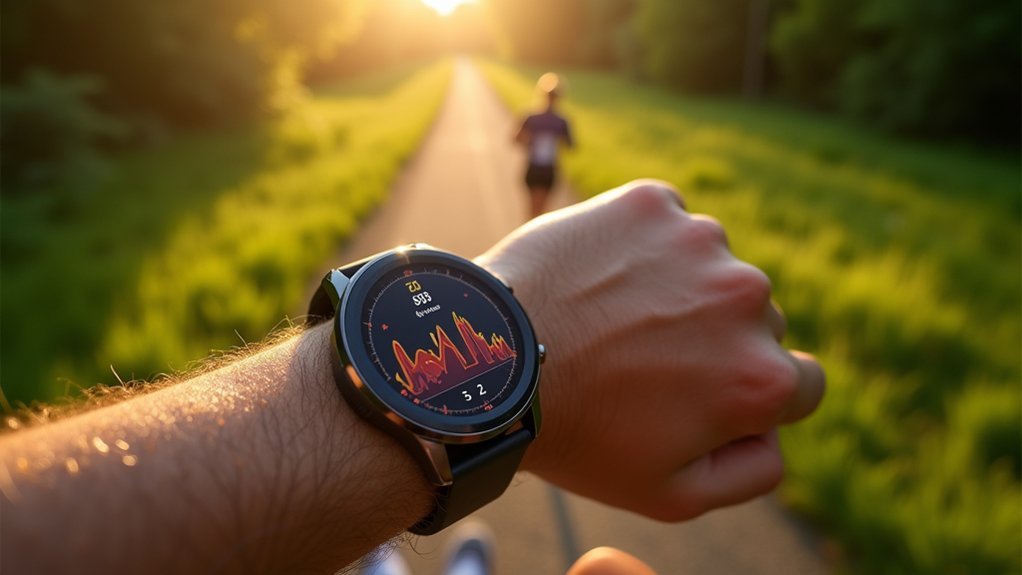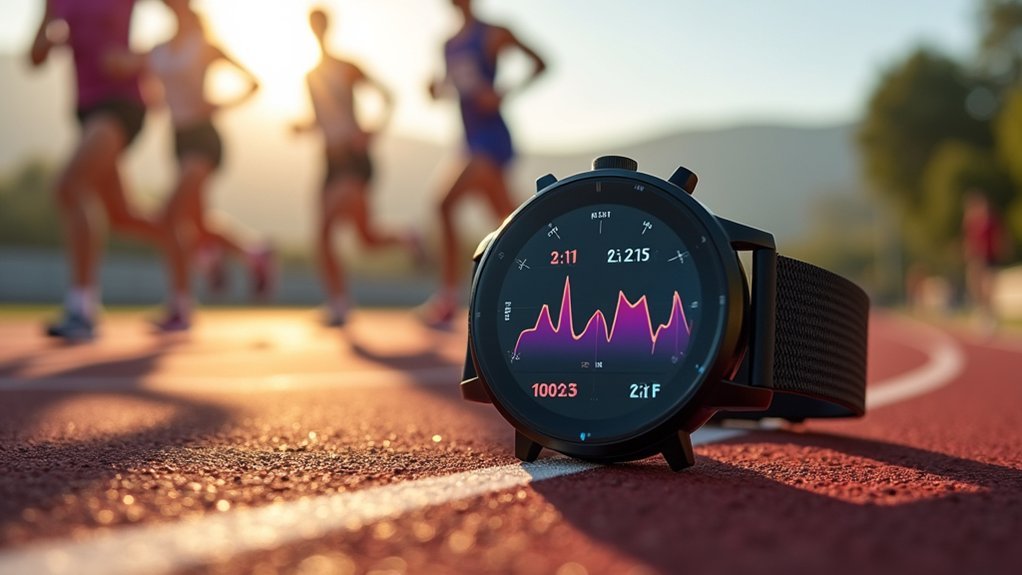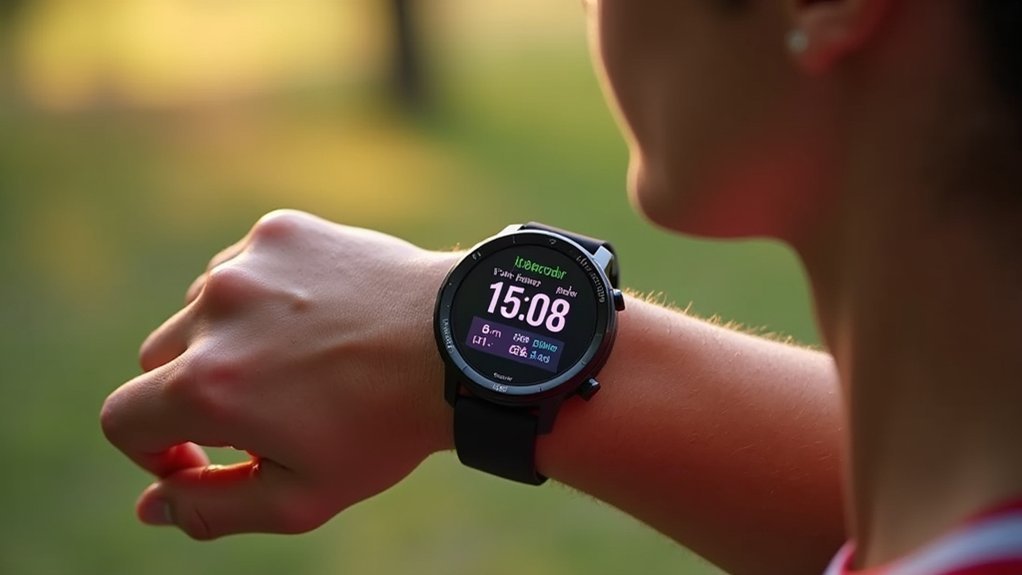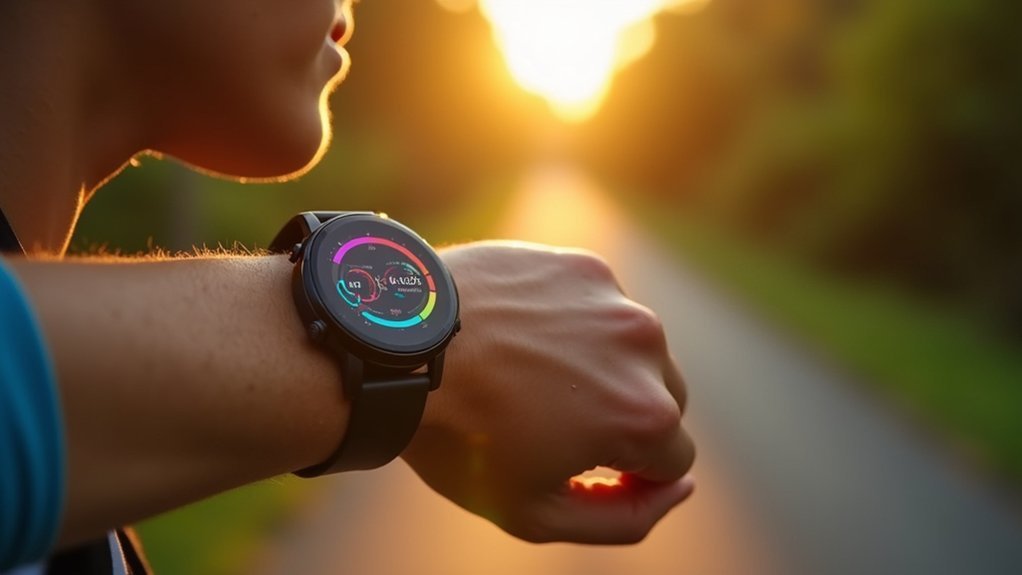To effectively track running power with your smartwatch, prioritize devices with GPS accuracy, connect external power sensors like Stryd foot pods, and guarantee compatibility with your training apps. Set up personalized power zones based on your FTP test results, optimize battery life by adjusting screen brightness and sampling rates, and customize data fields for easy viewing. Keep your zones updated every 4-6 weeks as your fitness improves. These foundational steps will transform how you analyze and improve your running mechanics.
7 Tips: Smartwatches Tracking Running Power Data

Five key factors deserve consideration when selecting a smartwatch for running power data.
First, prioritize GPS accuracy to guarantee reliable power metrics across your running routes.
Battery life is vital—look for watches offering up to 45 hours of continuous GPS tracking or extended life in lower power modes for ultramarathoners.
Consider compatibility with external power sensors like Stryd foot pods, which enhance real-time tracking beyond what the watch alone can provide.
Check that your potential purchase integrates seamlessly with your preferred training apps such as TrainingPeaks for efficient workout management.
Finally, evaluate display quality—AMOLED screens offer superior readability during daytime runs but may drain battery faster than alternatives. For professional-grade accuracy, consider watches with multi-band GPS capability like the Garmin Forerunner 265 for precise power data even in challenging environments.
Balance this against your typical running conditions and duration requirements.
Understanding Power Metrics for Optimal Performance
Unlike traditional metrics that only tell part of the story, running power quantifies your actual mechanical work output in watts, providing a direct measure of effort that remains consistent regardless of terrain.
By tracking your Functional Threshold Power (FTP), you’ll establish personalized training zones that guide workout intensities from recovery to VO2 max.
Establishing your FTP creates a personalized power roadmap, revealing precisely how hard to push in every workout scenario.
Watch for increased power at the same heart rate or pace—this signals improved running economy.
Power data reveals biomechanical efficiency changes through cadence and stride adjustments that pace alone can’t capture.
During races, maintain consistent power output rather than consistent pace on hills to prevent early burnout and optimize energy management.
For best results, integrate power with heart rate and pace for an extensive view of your performance, enabling smarter training decisions and more strategic racing.
Modern running power meters use sophisticated 3D acceleration data to calculate power output, giving runners unprecedented insights into their performance metrics.
Selecting the Right Watch for Power Data Collection

With running power metrics offering such valuable performance insights, your next step is choosing a smartwatch that can reliably collect this data. When selecting your device, prioritize features that guarantee accurate, accessible data collection.
- Battery life is essential—opt for watches like the Suunto 9 Baro that can track for days without recharging.
- Data export capabilities matter; Polar devices excel at providing full access to your running metrics.
- Price point varies greatly, with Coros Pace 2 offering budget-friendly options without sacrificing essential features.
- Connectivity options should include Bluetooth for seamless syncing to your preferred analysis platforms.
- Integration with other health metrics enhances your training picture—look for sleep tracking and HRV analysis. Similar to how Rachel Petersen tracks heart rate zones during her runs, many power-tracking watches now offer zone-based training features for optimal performance management.
Setting Up Your First Power Zones
Once you’ve selected a power-compatible smartwatch, you’ll need to establish your functional threshold power (FTP) through a 20-30 minute maximal effort test.
Your FTP result becomes the cornerstone for calculating your personal power zones, typically ranging from Zone 1 (<55% FTP) for recovery efforts to Zone 6 (>120% FTP) for maximum intensity intervals.
After setting these zones in your device settings, you’ll immediately benefit from real-time feedback during runs, helping you train precisely within the intensity ranges that match your specific workout goals. If you encounter any issues while setting up your zones, remember that refreshing the application may resolve most loading errors quickly.
Setting Up First Power Zones
Before you can effectively train with power data, you’ll need to establish your personal power zones based on your functional threshold power (FTP). Most models use five to seven zones calculated as percentages of your FTP. TrainingPeaks, for example, divides effort into zones ranging from recovery (55% of FTP) to maximum effort (above 120%).
To create your zones and start training effectively:
- Test your FTP every 4-6 weeks to guarantee your zones reflect your current fitness
- Choose one zone system and stick with it for consistent progress tracking
- Use Zone 1-2 workouts to build your endurance base
- Target Zone 3-4 for developing strength and anaerobic capacity
- Reserve Zone 5-6 efforts for specific high-intensity interval training
Determine your FTP through a 30-minute time trial where you maintain the highest sustainable power output for the duration of the test.
Establish Baseline FTP Test
Establishing your initial power zones requires a solid FTP benchmark, which serves as the foundation for all power-based training decisions.
Before testing, make sure you’re well-rested and properly warmed up to avoid underestimating your potential.
Choose the test format that suits your fitness level—beginners might prefer the 8-minute test, while experienced runners can tackle the traditional 20-minute assessment.
Set a realistic target power to maintain consistent effort throughout the test.
For best results, conduct your test in controlled conditions using your smartwatch in slope mode.
Focus on maintaining steady pacing rather than starting too intensely and fading.
Your smartwatch data will help determine your functional threshold power, which represents the highest power output you can sustain for approximately one hour.
After completing the test, use training apps to calculate your zones based on your results.
Plan to retest every 6-12 weeks as your fitness improves to keep your training zones accurate.
Calculate Zone Percentages
Setting up your first power zones requires converting your FTP test result into practical training ranges that guide your workouts with precision.
After determining your threshold power, apply percentage-based calculations to establish each training zone in your smartwatch or app settings.
- Zone 1 (Recovery): Set at <65% of your threshold for easy running and active recovery
- Zone 2 (Endurance): Configure between 65-80% for building aerobic foundation
- Zone 3 (Tempo): Establish at 80-90% for sustainable challenging efforts
- Zone 4 (Threshold): Define as 90-105% for workouts at or near your lactate threshold
- Zone 5+ (VO2Max/Anaerobic): Set above 105% for high-intensity intervals and sprint work
Following the 80/20 training philosophy, you should spend approximately 80% of your training time in Zones 1-2 and only 20% in the higher intensity zones to optimize performance while avoiding injury.
Remember to reassess your zones every 4-6 weeks as fitness improves.
Most running apps allow customization of these percentages to match your preferred training methodology.
Maximizing Battery Life While Tracking Power
You’ll optimize battery life by reducing screen brightness and timeout settings while tracking power metrics.
Lowering sensor sampling rates from continuous to intervals still provides reliable power data without excessive energy drain.
Enable battery-preserving training modes that prioritize essential power measurements while disabling unnecessary features like always-on display and constant heart rate monitoring. For maximum endurance during long runs, consider the Garmin Enduro 3 which offers exceptional battery life of up to three months with solar recharging capability.
Display Settings Optimization
How effectively you manage your smartwatch’s display can dramatically extend battery life during running power tracking sessions.
Lower your screen brightness or enable auto-brightness to balance visibility with power conservation. Disable the Always-On Display feature when tracking longer runs to considerably reduce battery drain.
For maximum efficiency during power tracking:
- Shorten your screen timeout duration to minimize active display time
- Choose simplified watch faces without animations or complex graphics
- Disable “raise to wake” and touch activation to prevent accidental screen activation
- Consider using monochrome or low-power display modes when available
- Enable Battery Saver mode for ultra-long runs, understanding it may delay some data updates
Classic Galaxy Watch models can also disable bezel rotation wake to further prevent unintended screen activations during vigorous running movements.
These adjustments guarantee your watch stays powered throughout your entire training session without sacrificing essential power metrics.
Sensor Sampling Rates
Beyond display settings, sensor sampling rates represent a powerful lever for extending battery life during power tracking runs. Most commercial smartwatches sample physiological data at 20-64 Hz, striking a balance between accuracy and power consumption.
You’ll gain significant battery advantages by enabling adaptive sampling features on your device. These smart algorithms automatically reduce sampling frequency during steady running phases and increase it only when your pace or terrain changes, saving up to 70% in energy consumption. Recent research shows that implementing change point detection techniques can further reduce energy consumption by identifying activity transitions more efficiently.
For all-day tracking, consider manually lowering sampling rates to 20-30 Hz—sufficient for reliable power data while dramatically extending battery life.
Remember that higher rates (100+ Hz) provide minimal additional accuracy but drain batteries rapidly. If your watch allows customized firmware settings, program data capture intervals of 30 minutes for peak energy efficiency during longer runs.
Battery-Preserving Training Modes
When tracking running power data, activating specialized battery-preserving training modes can considerably extend your smartwatch’s runtime while maintaining essential metrics.
These modes disable non-essential functions while preserving critical power tracking capabilities.
- Enable “Exercise Power Saving” on newer Galaxy Watch models to maintain multi-day tracking with interval-based GPS and heart rate monitoring.
- Disable Bluetooth and WiFi when your watch is paired with your phone to reduce synchronization drain.
- Switch to a monochrome watch face during activities to considerably lower GPU processing demands.
- Adjust heart rate sampling to activity-only tracking instead of continuous monitoring.
- Use your connected phone’s GPS when possible to offload positioning tasks from your watch.
Watch Ultra models feature an exclusive Exercise Power Saving Mode that sacrifices GPS accuracy for significantly extended battery life during workouts.
Integrating Power Data With Training Apps
As runners increasingly embrace power metrics in their training regimens, the seamless integration of this data with various training apps has become essential for maximizing performance benefits.
Your smartwatch’s power data can work across multiple platforms through Bluetooth connectivity, giving you extensive performance insights wherever you train.
For best results, connect your device with platforms like Garmin Connect or TrainingPeaks to create structured workouts with power targets. This integration enables real-time feedback during runs and detailed post-workout analysis across your devices. Advanced analytics merge your wearable data to provide a unified view of all fitness metrics and running power progression.
Most quality apps support both iOS and Android, ensuring you’re never limited by your smartphone choice.
When setting up your integration, prioritize apps that offer customizable workouts and cross-platform compatibility.
This ecosystem approach will help you maintain training consistency while providing the personalized insights needed to improve performance.
Troubleshooting Common Power Reading Errors

Despite the growing reliability of smartwatch power metrics, most runners will eventually encounter frustrating data inconsistencies that can derail training sessions.
Power data hiccups are an inevitable part of the smartwatch experience for runners committed to metrics-based training.
When your power readings disappear or show errors, try these proven fixes:
- Restart your Garmin watch as a first step to clear temporary glitches affecting power data
- Confirm a power data field is properly configured on at least one of your activity screens
- Avoid using both ANT+ and Bluetooth simultaneously for power devices to prevent data conflicts
- Check for the “IQ!” error symbol, which indicates Connect IQ app issues needing attention
- Consider a factory reset for persistent problems, but reinstall only essential power apps afterward
Many users report that the previously functional “Account for Wind” feature in training summaries has been showing wind information unavailable since recent software updates.
Remember to sync your watch with Garmin Connect after troubleshooting to confirm settings are properly updated.
Frequently Asked Questions
How Does Altitude Affect Running Power Measurements?
At altitude, your running power measurements may read higher than your true physiological output due to decreased oxygen, sensor calibration issues, and altered biomechanics—despite feeling harder, your actual power production is likely reduced.
Can Power Metrics Predict Race Performance on Unfamiliar Courses?
Yes, power metrics can predict your race performance on unfamiliar courses. They account for elevation profiles, terrain challenges, and your fitness data, providing about 87-90% accuracy through platforms like Stryd’s Super Power Calculator.
Do Different Brands Calculate Running Power Using Consistent Formulas?
No, brands don’t use consistent formulas for running power. You’ll find significant differences between Garmin (using external sensors and wind data) and Polar (using only watch data) calculation methods, making cross-brand comparisons unreliable.
How Frequently Should Power Sensors Be Recalibrated?
You should recalibrate power sensors monthly with heavy use, quarterly for casual use. Follow manufacturer guidelines, as medical-grade sensors require strict 28-day cycles. Environmental changes or impacts warrant immediate recalibration.
Can Power Data Identify Potential Injuries Before They Occur?
Yes, power data can identify potential injuries before they occur. You’ll notice declining power outputs, asymmetries, or irregular patterns that signal fatigue or biomechanical issues before they develop into full injuries.
In Summary
Running power data transforms your training when you use it effectively. You’ll gain deeper insights into your performance as you master these metrics on your smartwatch. Remember to regularly update your power zones, monitor battery usage, and sync with your favorite apps. When troubleshooting issues, check for firmware updates and sensor positioning. Embrace this technology and you’ll discover a more scientific approach to improving your running efficiency.





Leave a Reply